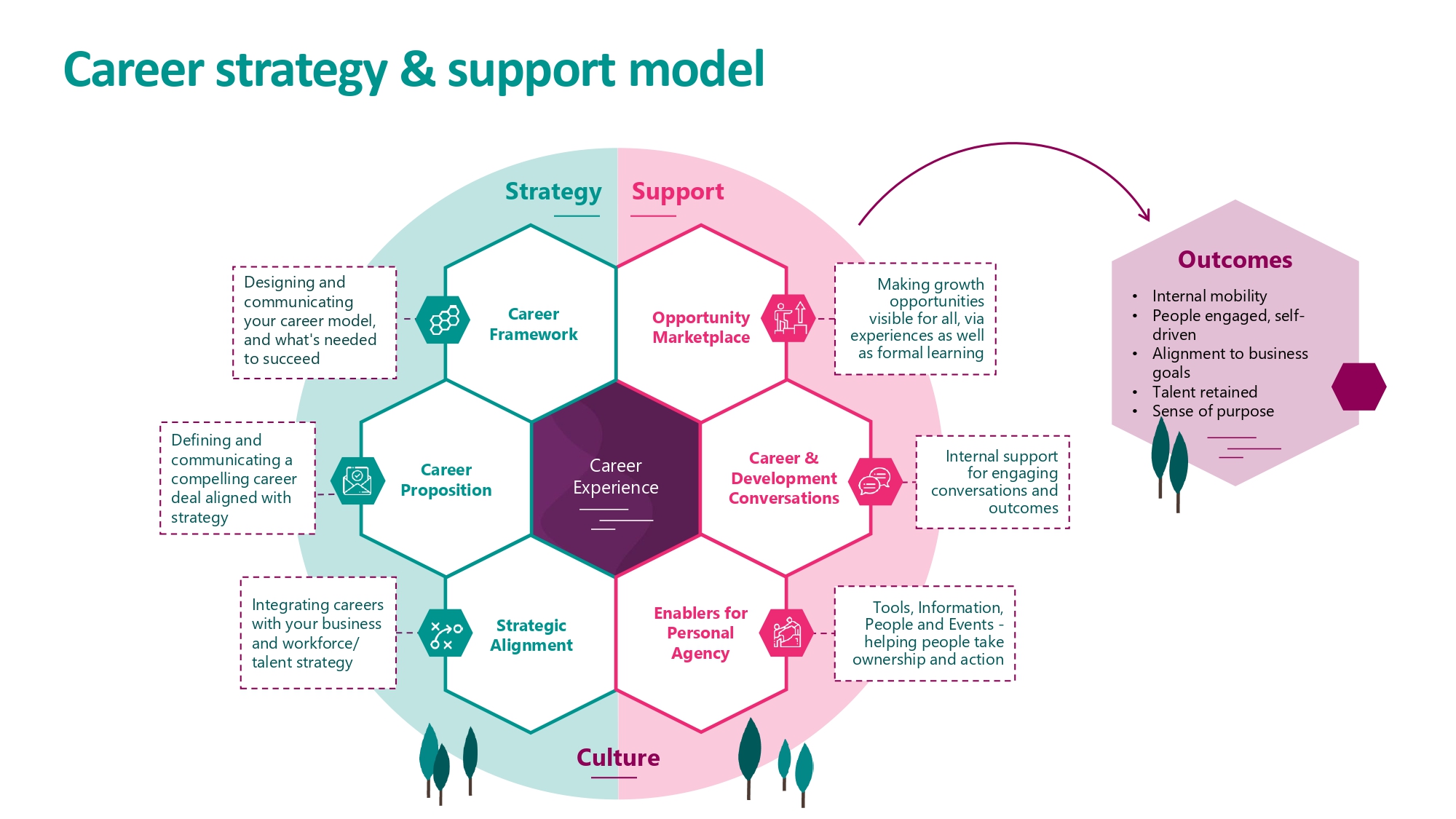We all know people who have been asked to take on additional responsibilities at work, maybe to cover a gap after someone more senior has left, but then do not get a pay rise even when that temporary stretch becomes permanent. Dislocations between what the organisation wants from individuals in their careers and what it rewards are commonly experienced. These experiences are enormously frustrating for individuals who feel cheated or unfairly treated, but they also damage relationships at work, motivation, retention and employer brand.
We explored the issue of how to align career and reward strategies at a recent virtual roundtable. In this article we highlight opportunities to better connect current career development messaging and practice with reward policy and its implementation. We’ll outline a way forward where both the company and the individual benefit, sharing the additional value created by purposeful career development. What could be more important at a time of flux when so many people are thinking hard about the next step in their career and their financial futures?
Who needs to be aligned and why?
There are three parties to this issue, each with different agendas and desired outcomes.
The employee
When individuals are asked how they measure their career progression, they usually talk first about personal challenge, stretch, a sense of purpose, and opportunities to develop and learn new skills. While valuing these intrinsic benefits, they also talk about the importance of recognition and the tangible rewards which will secure their long-term financial position. Most employees can only significantly improve their earnings through upward career progression and so expect the two to go hand in hand.
The reward specialist
Conventionally, the reward specialist’s emphasis is more short term, with the priority being the ability to fill current jobs in the context of external pay levels. Grades with narrower pay scales have been designed to control costs, and benchmarking for relative reward helps to justify pay levels to senior leaders. The fact that any incentives still tend to focus on short-term individual performance reinforces the signal to employees at all levels that this is what the organisation values.
The career professional
Career professionals encourage organisations to be more inclusive and adopt an approach that works where structures are flatter, and promotion opportunities are more limited. They often advise individuals to recognise the legitimacy of different types of career, the potential of lateral moves to broaden experience, the importance of continuous learning, and the value of initiating conversations about future opportunities with career enablers. Career professionals often simply ignore the evident financial consequences for individuals of the kinds of careers they advocate.
With these different players involved pushing and pulling in somewhat different directions, it’s easy to understand how misalignment occurs between careers and reward in organisations. This presents a significant problem. Without a strong and positive integration of careers and reward, one that identifies where greater flexibility and change are needed, all our efforts to prepare employees for the future world of work may end up breeding cynicism, rather than delivering truly rewarding careers.
Common misalignment scenarios and the questions you need to ask
Here are some situations we’ve experienced, with questions to help you reach an equitable solution
My organisation says it values agility and breadth of experience. It encourages individuals to consider strategic projects and lateral moves, but for the same pay.
- What are the real business benefits of cross-organisation career experience and for what kinds of work and people does it add value?
- Will broader experience help individuals advance their careers or just offer variety in lieu of promotion?
- If the organisation wants the increased skills and flexibility employees offer through lateral careers, how will it reward them fairly for this increased value?
Cross-organisation career building of talented individuals is discouraged or blocked by line managers who prioritise retaining their best people.
- How does the design of performance goals and incentives inhibit managers from sharing and nurturing talent for the benefit of the whole organisation?
- Are we clear why we want internal talent mobility? Have we explained this properly to everyone?
- Do we recognise, reward and promote managers who do develop their people and encourage them to pursue their careers across the organisation?
We recruit externally over the heads of good employees at inflated cost
- Do we go to the external market even when we have good reason to believe we have strong internal candidates?
- Are external hires worth the extra money we pay for them?
- What does it say about our career development strategy if home-grown talent believe the only way to get a significant pay rise is to leave?
Short pay scales deliver cost control, but limit pay progression for senior professionals and skill development within the same job or grade
- How does our reward strategy acknowledge job mastery, and the time this takes to develop, in skill areas critical to the business?
- We say people can build careers within the same type of role, but do we need broader pay bands for career ceiling jobs to reward the contribution of our highest performers within the same grade?
- Are we prepared to train and support managers to use broader pay bands effectively?
Becoming a manager seems the only route for technical and professional employees to get more pay.
- Are we clear about the value senior contributor roles add, and does our job evaluation and pay system give enough weight to job complexity and influence, not just job size in conventional managerial terms?
- Can some senior roles reflect a mix of leadership and technical skills that make best use of an individual’s interests and talents?
- What other forms of recognition would be valued and appropriate for senior technical/ professional staff?
What will it take for careers and reward to start pulling in the same direction?
A first step is for career professionals to recognise that an integrated career strategy requires the reward function to be a central part of the conversation. This will help to fully explore the practical implications of establishing career principles like:
- reaching for win-win outcomes that work both for the business and for the individual
- valuing different types of career and the learning and flexibility we need from employees
- using both career development and reward to support our values and the wider organisational culture we are seeking to promote
- the importance of both breadth and depth for different work and different people
- internal mobility and lateral movement to add value to the business and to individuals
- growing internal talent and how to balance this with bringing in ideas from outside
- helping managers to listen and talk more honestly with employees about careers and reward, to find fair solutions to often thorny challenges
Assuming the organisation’s values include treating people fairly and seeking win/win outcomes, this can open up discussions about how additional business value is generated through career development and then how this can be shared with individuals today. Asking employees to build their own career plans round a ‘jam tomorrow’ philosophy really will not do.
Another agenda item is to ensure that existing staff with similar experience to external recruits are properly compensated. As one contributor to our recent roundtable commented:
‘great managers are empowered and capable of being proactive about this’
This approach will require openness and flexibility from career and reward professionals. Their aim should be to craft:
- a credible story for senior leaders about the business benefits of focused career development
- a compelling narrative for employees that is transparent about the kinds of career on offer, the relationship between career development and pay progression, including the ‘total reward’ package
- a reward policy that accommodates the changing interests and needs of individuals as they progress through their career and contribute in varied ways to the business
The strategy, policies and practices that emerge should be tailored to each organisation’s context and needs, and the kinds of people they employ.
Strategic alignment: the bigger picture
While the relationship with reward is fundamental to a positive employee experience, career strategy also needs to align with other HR disciplines. These include: workforce planning, job design, performance management, learning and development, talent management, recruitment, OD, D&I, and employee experience. Each has the potential to help or hinder a positive outcome, and together they explain the reason we showcase strategic alignment as a key dimension of our Career Strategy model.
If you haven’t already done so, it’s time to shift from a siloed and tactical approach to career development, to a collaborative one based on robust conversations with HR colleagues in a range of disciplines. We’re confident that organisations doing this will quickly reap the benefits through higher levels of engagement, productivity and retention.
The authors
David North, Senior Consultant, The Career Innovation Company and Dr Wendy Hirsh, Principal Associate at the Institute for Employment Studies and Visiting Professor of Career Development at the University of Derby.






